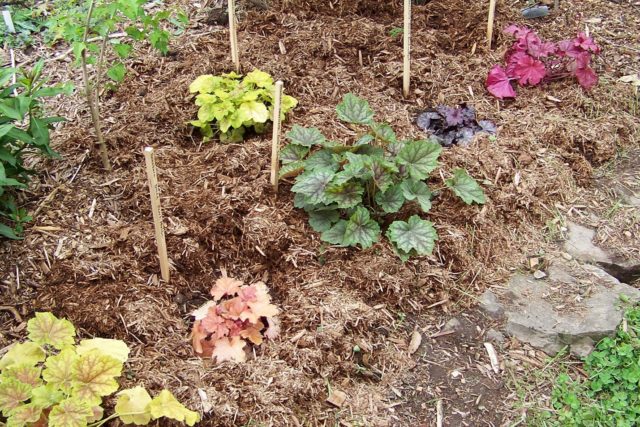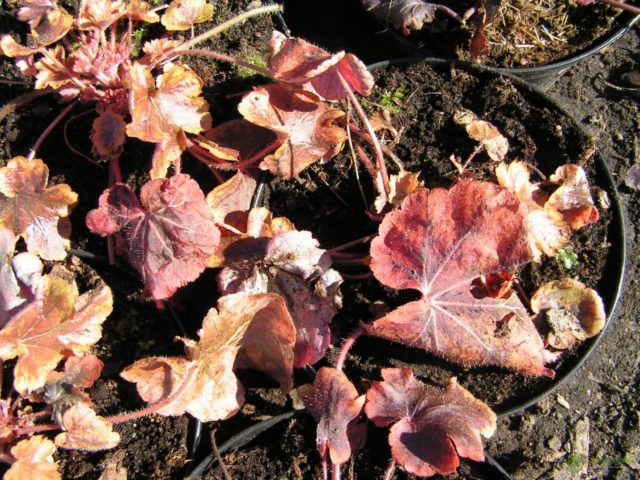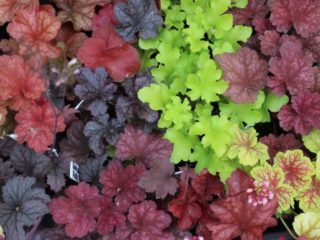Content
This type of heuchera fully lives up to its name. Original leaves of various shades resemble a box of marmalade. There is everything your heart desires here. Heuchera Marmalade, like a chameleon, periodically changes the color of its leaves. Bright, rich shades give way to deep dark tones.
The mysterious nature of this plant has captivated the whole world. Heuchera appeared from North America. As a true representative of the saxifrage family, in nature it grows on mountain slopes. Such unpretentiousness to the composition of the soil and high decorative value have made Heuchera Marmalade one of the leaders in garden plants.
Description of Heuchera Marmalade
Heuchera Marmalade, a photo and description of which is presented below, is one of the most beautiful varieties. A compact, dense bush about 50 cm high is decorated with corrugated leaves. Their color palette includes various shades of green and pink. Purple and silver specimens look especially impressive. The top of the leaf plate is decorated with original patterns consisting of spots, specks and veins.
The flowering period of Heuchera Marmalade begins in June and lasts two months. The buds look like small bells. When they bloom and bloom, boxes with seeds form in their place, each of which is no larger than a poppy seed.
In order for the plant to delight with its beauty for a long time, the soil is not over-moistened and a rejuvenation procedure is carried out every 3-5 years.
Heuchera Marmalade in landscape design
In Heucher's flower beds, Lime Marmalade (pictured) easily leads the way. The bright prima often does not need the company of other plants. Bushes of contrasting colors or specimens of the same color, but with different patterns on the leaves, are planted nearby. Single plantings are usually used to decorate borders and discounts.
To create shade for Heuchera Marmalade, they are placed next to coniferous and deciduous trees. Ornamental grasses, roses, hostas, tulips, irises and daffodils will also be good neighbors. Heuchera Marmalade will be able to show themselves in all their glory in high fenced flower beds. These plants are also grown in containers. The tubs are placed at the front entrance to the house or on the terrace.
Growing Heuchera Marmalade from Seeds
Planting material can be prepared independently or purchased at a specialized store. Be sure to pay attention to the expiration date. For seeds in regular bags it is six months, in foil bags – 18 months.
Sowing Heuchera Marmalade seeds consists of several stages:
- Selection of containers. The container should be wide, with a side height of about 5 cm. Holes must be made in the bottom to drain excess moisture.
- Soil preparation. Loose soil is mixed with perlite and sand. The resulting mixture is disinfected in the oven (5 to 7 minutes). You can simply pour boiling water over it and let it dry a little.
- Landing. Heuchera Marmalade seeds are microscopic grains. Working with them is difficult. It is first recommended to combine them with sand, distribute them over the surface of damp soil and level them. There is no need to deepen the planting material. The top of the container is sealed with transparent polyethylene and placed on a bright windowsill away from drafts. Next, provide normal care, consisting of regular ventilation and moisturizing. With the appearance of the first sprouts, holes are made in the film cover. This way the plants will get used to the air faster.
- Picking. Each sprout of Heuchera Marmalade should form three strong leaves. Now you can plant the heucheras in new containers, leaving 5-6 cm of free space between the shoots. During this period, it is especially important to monitor watering. Dampness or drought will destroy young plants. When stable warmth has established (approximately by the second half of May), the container with Heuchera Marmalade is dug into the garden soil in a shaded place. This will allow the shoots to get stronger and safely carry out the final transplant into open ground.
Planting and caring for heuchera Lime Marmalade in open ground
Although Heuchera Marmalade is undemanding in care, in order for this herbaceous perennial to please with its appearance, some rules must still be followed.
Preparing the landing site
The decorative effect of Heuchera Marmalade will depend on the correctly selected site.Specimens whose leaf color is dominated by shades of red need a fairly bright place. For other varieties, partial shade is suitable, when the sun shines only in the morning. According to the description, Heuchera Lime Marmalade belongs to the latter. That is, it must be planted in a shaded place. In this case, the site must be protected from gusts of wind and drafts. Lowlands with stagnant melt and rainwater are not suitable.
Heucheras Marmalade prefer fairly loose and fertile soil. The soil must be well-permeable to moisture and oxygen. The optimal acidity level is 5-6 pH. Before planting, the area is cleared of weeds, dug up and loosened.
Landing rules
The best time is considered to be early spring. You can plant your own seedlings or purchase seedlings. A square hole is dug on the site, the width and depth of which are 30 cm. Wood ash, well-rotted compost and fertile soil are poured into it. All ingredients are thoroughly mixed.
Heuchera seedling Marmalade is cleaned of rot and defective areas are cut off. Coal chips are used as a disinfectant. Afterwards, the cuttings are placed in the hole and sprinkled with earth. In a month to a month and a half, the root system will be fully formed and strengthened. If necessary, the plant can be replanted. Delenki with rosettes are planted in September, providing protection from temperature changes.
Watering and fertilizing
The soil is moistened every two days. It is important to ensure that the top layer of soil has time to dry. On the hottest days, watering is increased. Water is applied only at the root; the leaves should remain dry.
The condition of a flower is judged by its appearance. If the leaf blades become dull, become smaller and become lethargic, it’s time to fertilize.
Trimming
Heuchera Marmalade flowers are not the most beautiful. So that they do not take away the strength of decorative leaf plants, they are pruned. In summer, young leaves actively grow, and old and dried ones are periodically removed. Leaves do not need pruning for winter.
Preparing for winter
In southern regions with warm winters, heucheras do not need to be covered. If the climate is harsh, the shoots are insulated with lutrasil or spruce branches. There is no need to make a too dense covering for Heuchera Marmalade, as the plant must breathe. Container specimens are transferred to the winter garden, to a glazed terrace or to the basement. In the spring, using pruning shears, carefully cut out all the old shoots.
Reproduction
In addition to propagation by seeds, there are two more effective ways to propagate Heuchera Marmalade:
- Division. The most favorable time is May or September. The bush needs to be dug up and rotten or too long roots must be removed. Next, using a sharp and disinfected blade, the rhizome is divided into several parts. The resulting cuttings are immediately immersed in the ground down to the first pair of leaves. Water and cover with thick film. Within 2 weeks the bushes will take root.
- Cuttings. Before the Heuchera Marmalade bush blooms or immediately after that, you can start harvesting cuttings. To do this, shoots from 5 to 8 cm long are cut. The cut areas must be treated with “Kornevin” or another preparation. Afterwards, the plants are transferred to containers with moist soil or sand. A cap is made of glass or polyethylene on top. After a month, the cuttings will take root.
Diseases and pests
Heuchera Marmalade has good immunity to diseases and is rarely attacked by pests. But if not properly cared for, the plant weakens. The cause of disease development is increased humidity or acidity, as well as excessive feeding with organic components. All this leads to the appearance of root rot, rust on leaves and powdery mildew. Removing the affected parts and treating the plant with fungicides will help protect the plant from diseases.
Conclusion
Heuchera Marmalade is one of the most colorful and unpretentious garden plants. Wavy bushes of fancy colors will not go unnoticed. They will turn your garden plot into an exotic corner with colorful lanterns.















